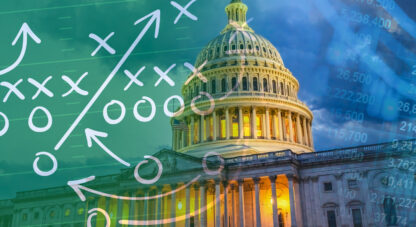Assessing the Powell Pivot
The US Federal Reserve took center stage this week in a highly anticipated FOMC meeting on Wednesday. There, the central bank confirmed that it is shifting the primary focus of its attention toward fighting inflation and adopting a more hawkish policy stance. The bank announced plans to double the pace of tapering its asset purchases. While it retains the option to make further adjustments as conditions warrant, the tapering that had previously been set to conclude around June of 2022 is now on track to conclude by March of next year.
In addition, Fed Chairman Powell indicated in his press conference that, unlike in the previous rate hike cycle, this time the Fed will not need to wait to initiate rate hikes following the end of tapering. Projections for future Fed interest rate hikes increased to three rate hikes in 2022 from just one hike previously. In addition, market-based odds pulled forward expectations for the most likely timing of a rate-hike liftoff to May from previous expectations for the summer of 2022.
Major market indexes traded in volatile fashion throughout the week. Markets sold-off heading into Wednesday’s Fed meeting, surged higher Wednesday afternoon following Fed Chairman Powell’s press conference, then resumed the selloff to close the week lower across the board. Of the majors, the Nasdaq was the hardest hit index.
The fierce but ultimately brief Wednesday afternoon rally following the Fed meeting was initially interpreted by many market commentators as a bull market all-clear signal suggesting that a hawkish Fed poses no threat to an ongoing surge higher in stock prices. Second thoughts quickly entered the picture, however, as the rally reversed Thursday and Friday. Adding to the risk-off tone was the fact that the defensive sectors outperformed across the board. Interestingly, defensive outperformance was evident even during Wednesday’s sharp rally. Beyond stocks, the dollar rallied, bond yields dropped, and commodities were mixed. Precious metals rallied, copper was slightly higher, while oil and natural gas fell.
Some of the best post-FOMC commentary came late this week from former Treasury Secretary and former National Economic Council director Larry Summers. Over the last year, Mr. Summers has been one of the earliest and most vocal critics of both the fiscal and monetary policy responses to the Covid pandemic. Summers’ voice of dissent from current policy orthodoxy was particularly noteworthy as it came from a man associated with both the Clinton and Obama administrations. His fear: Policymakers have been instigating a significant inflation problem. He warned of serious inflation at a time when the Fed and most market participants were entirely dismissive. Summers warned that inflation was coming, that it would be persistent, and that the levels of inflation reached would be dramatically higher than many assumed. To date, his concerns have been spot on. He’s been ahead of the Fed every step of the way.
So, how does Mr. Summers assess the recent “Powell pivot” and the resulting hawkish policy lean in this week’s FOMC meeting? In short: It’s not enough. In an interview with Bloomberg, Mr. Summers said, “I expect, in the end, it won’t have been enough.” He suggests that while the Fed has retired the word “transitory,” the still-insufficient policy response demonstrates that it hasn’t actually abandoned the “concept that inflation is going to solve itself.” He says, “that idea was wrong…and I think that idea is still very present, and my fear is that it’s a problematic one, and my fear is that it’s an idea that’s going to do damage to policymakers’ credibility.” According to Summers, “…what the Fed is assuming is a future of ‘3.5% unemployment for three years with steadily decelerating inflation…’ and that they will achieve this outcome ‘without the interest rate ever getting as high as what they think the neutral rate is….’” In other words, Summers points out that this policy doesn’t have the bite to knock out inflation, but actually still depends on inflation being mostly transitory and falling on its own.
The most recent Consumer Price Index reading was 6.8%, and the Producer Price Index this week read a blistering 9.6%. Even with the hawkish assumption of three interest rate hikes in 2022, we are nowhere near attaining positive real interest rates. Unless inflation drops substantially on its own or the Fed gets much more aggressive, we will continue to have deeply negative real interest rates as far as the eye can see. Perhaps the Fed knows something economic theories have missed. If not, negative real interest rates are not at all a means to fight inflation.
Mr. Summers continues: “Here’s what I see. Shelter is a third of the CPI. I see house prices going up 20%. I see every private sector rental index up in double digits… [T]hat says to me we’ve got another 8-10% of shelter inflation coming….” He sees shelter inflation, at a third of the total CPI calculation, contributing another 3% to future CPI.
Next, Summers turns to the labor market as another major contributor to inflation. “I see a red-hot labor market with labor shortages, with hourly wage rates accelerating, and ultimately labor’s the most important source of cost…. All the businesses I talk to, all the businesses where I read reports from stock analysts say [labor has] got a lot of pricing power.” Here Mr. Summers is pointing out the dramatically increased bargaining power of labor, and workers’ leverage to drive a classic inflationary wage-price spiral.
With higher inflation pending from both shelter and labor, almost no productivity growth, and consensus expectations for the economy to grow at about 4% next year; the former Treasury Secretary says that while Fed policy might be right, “I don’t think we can plan on it.”
So how does Larry Summers grade the new Fed policy pivot to knock out inflation? Not very highly. In a separate Op-ed in the Washington Post on Thursday, Mr. Summers offered his final assessment, concluding that “even with its actions this week, the Fed remains well behind the curve in its commitment to fighting inflation… [T]his is a matter of serious concern.”
Another prominent Fed insider agrees, and takes the inflation-fighting policy suggestions beyond tapering and raising interest rates. Federal Reserve Governor Chris Waller spoke on Friday at the Forecasters Club of New York. According to Reuters, Waller referred to inflation as “alarmingly high,” and suggested that after ending the taper of bond purchases in March, the Fed should also increase interest rates at the Fed’s March FOMC meeting. Waller went on to recommend that after “some” hikes, the Fed should see if inflation backs off. He went on to say, however, that, “If it doesn’t, then we have to move faster, we have to do more. Balance sheet runoff would help in that.” This is where Waller pushes the envelope further. Rather than merely ending additional asset purchases, as the completion of the taper will do, “balance sheet runoff” means outright reversal of the accommodative quantitative easing policy by actually shrinking the Fed’s balance sheet with quantitative tightening.
Past HAIs have offered the opinion that the market’s faith in an unerring and omnipotent Fed perfectly managing both the economy and asset prices has increased dramatically over the past decade. That faith has facilitated a shift on the part of markets from a relative underweighting of the importance of underlying fundamental economic analysis toward a relative overweighting of the idea that central banks will do whatever it takes to ensure continually rising markets. If Larry Summers is right about ongoing inflation, and, as a result, Fed Governor Waller is correct that in the not-too-distant future the Fed may be forced to tighten financial conditions with outright balance sheet reductions, then that faith in Fed protection may be misplaced. We may have an imminent threat to record-high stock market valuations on our hands.
In considering the monumental market relevance of an active Fed policy of balance sheet reduction, recall an observation from Bank of America featured in several HAIs past. BofA estimated that, prior to the 2008 financial crisis, corporate earnings drove half of all equity market returns. Since the crisis, however, as the Fed has dramatically escalated its active economic management, BofA believes that corporate earnings explain only 21% of returns. Since 2010, the bank estimates that changes to the Fed’s balance sheet alone now account for 52% of market returns. So, according to BofA, market valuations are now primarily derived from and dependent upon increases and decreases in the Fed’s balance sheet. If correct, in addition to the restraining effect on economic growth that will come from tighter financial conditions, a “balance sheet runoff” will directly translate to a dramatic reduction in market valuation.
Returning to Larry Summers, in his Op-ed, he makes the same astute point that echoes last week’s observation from University of Michigan Surveys of Consumers chief economist Richard Curtin. Summers states that, “The not-very-encouraging history of disinflation efforts suggests that the Fed will need to be both skillful and lucky as it seeks to apply sufficient restraint to cause inflation to come down to its two percent target without pushing the economy into recession.
“There have been few, if any, instances in which inflation has been successfully stabilized without recession. Every US economic expansion between the Korean War and Paul A. Volcker’s slaying of inflation after 1979 ended as the Federal Reserve tried to put the brakes on inflation and the economy skidded into recession. Since Volcker’s victory, there have been no major outbreaks of inflation until this year, and so no need for monetary policy to engineer a soft landing of the kind that the Fed hopes for over the next several years.”
It would be a mistake to count out the Fed, but perhaps the aggressive flattening that can be witnessed in the Treasury yield curve and even the recent inversion of the Eurodollar futures curve are market caution flags signaling that the “soft landing of the kind the Fed hopes for” may be hard to attain. As these dynamics increasingly come to a head, it will be interesting to see if gold, the relatively economically insensitive store of value, will attract greater investor appeal.
As for weekly performance: The S&P 500 fell 1.94% this week. Gold was up by 1.13%, while the price of silver increased by 1.53% on the week. Platinum was nearly flat, up 0.03%, while palladium gained 2.00% in a highly volatile week. The HUI gold miners index was up 2.26%. The IFRA iShares US Infrastructure ETF was down 1.42% for the week. Energy commodities continue to be volatile. WTI crude oil lost 1.33%, while natural gas lost another 5.99% on the week. The CRB Commodity Index was up 0.83%, while copper was up 0.21%. The Dow Jones US Real Estate Index ended the week up 1.93%, while the Dow Jones Utility Average Index was up 1.54% on the week. The US Dollar Index was higher this week by 0.47% to close the week at 96.55. The yield on the 10-year Treasury dropped by 7 bps to close the week at 1.41%.
Happy Holidays!
Best Regards,
David McAlvany
Chief Executive Officer
MWM LLC















